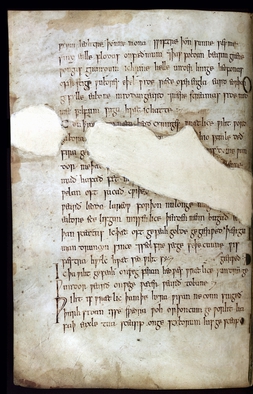Exeter Book Riddles 68-69 facts for kids
The Exeter Book Riddles 68 and 69 are two short puzzles found in a very old book called the Exeter Book. This book was written over 1,000 years ago, around the year 975. These riddles are part of a larger collection of Old English riddles. Experts believe these particular riddles are about 'ice'.
Contents
Unlocking the Ice Riddles
What are the Exeter Book Riddles?
The Exeter Book is a famous collection of poems and riddles. It comes from Anglo-Saxon England, a time long before modern English. The book is kept safe in Exeter Cathedral in England. It contains many different types of poems. Among them are nearly 100 riddles. These riddles are like brain teasers from the past. They describe everyday objects or natural things. But they do so in a mysterious way. The reader has to guess what is being described.
Riddle 68 and 69: One or Two?
In the original Exeter Book, Riddles 68 and 69 look like separate texts. You can see this in the image of the book's page. However, for a long time, people have wondered if they should be read together. Some scholars think they make more sense as one longer riddle. If combined, they fit the usual style of other Old English riddles better.
Here is Riddle 68 by itself, as it appears in the book:
|
Ic þa wiht geseah on weg feran; |
I saw that being travelling on a road; |
And here is Riddle 69, which is very short:
|
Wundor wearð on wege; wæter wearð to bane. |
A marvel occurred on the road: water turned to bone. |
When read together, they tell a more complete story. Many experts now think they might have been meant to be one riddle. This is despite how they are written in the old manuscript.
The Riddles Themselves
If we combine Riddles 68 and 69, they read like this:
|
Ic þa wiht geseah on weg feran; |
I saw that being travelling on a road; |
The solution to this combined riddle is almost certainly 'ice'. Think about it:
- "I saw that being travelling on a road" could describe ice forming or spreading.
- "She was decorated amazingly beautifully" fits the sparkling, intricate patterns of ice.
- "A marvel occurred on the road: water turned to bone" clearly describes water freezing into hard ice. Ice can be seen as the "bone" of water.
This makes the riddle a clever way to describe a common natural event. It shows how people in Anglo-Saxon times observed the world around them. They used poetry to describe it in a puzzling and beautiful way.


